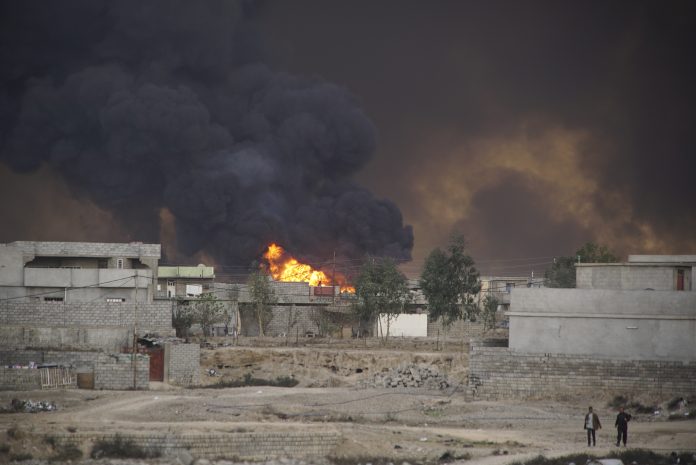
A U.S.-led airstrike carried out on a building in Mosul in March detonated a cache of Islamic State explosives, killing more than 100 Iraqi civilians, the Pentagon said Thursday.
An unclassified summary of the U.S. military investigation into the March 17 incident determined that the 500-pound bomb used in the strike set off additional explosives that were placed in the building by the Islamic State, causing the collapse of the structure.
The blast killed two Islamic State snipers and 105 civilians, including four in an adjacent house in western Mosul’s al Jadidah district, the summary said. Thirty-six additional civilians who were allegedly killed could not be accounted for because of “insufficient evidence to determine their status or whereabouts.” In the days after the strike, some reports said that more than 200 bodies were pulled from the rubble.
The strike is probably the single deadliest civilian casualty incident in the nearly three-year-old air campaign against the Islamic State in Iraq and Syria. Following the public outcry from the strike, the U.S.-led coalition sharply decreased the number of sorties over Mosul in April, according to data analyzed by the nonprofit monitoring group Airwars.
In addition to determining the cause of the building collapse, the investigation also said that the mass of people killed in the strike had been invited to take shelter on the building’s lower floors by a neighbor. The Islamic State also warned them to leave, according to locals interviewed during the investigation.
This account is at odds with what the U.S.-led coalition’s top officer suggested eleven days after the strike during a Pentagon press briefing. At the time, U.S. Army Gen. Stephen Townsend said that it appeared that the civilians were herded there by the Islamic State and were being used as shields.
“What I don’t know is, were they gathered there by the enemy? We still have some assessments to do. I would say this – that it sure looks like they were,” Townsend said March 28. “The Iraqis firmly believe that they were gathered there by the enemy. And the people we’re talking to say that they were gathered there.”
In reality, U.S. forces and Iraqi troops failed to observe the mass of people enter the building even though the Iraqis on the ground could observe the building for three days before the strike, according to the summary.
On March 17, the Iraqi troops – the U.S.-trained Counter-Terror Services – had planned to advance into the neighborhood. Until that point, U.S. drones and other aircraft had observed Islamic State fighters evicting families in the area and shoring up their defenses in anticipation of the attack, according to the summary.
An hour after the start of the advance, Iraqi troops began taking fire from two Islamic State snipers from the second floor of the building that would eventually be struck. The summary says that militants were engaging the Iraqi forces with “effective fire” but offers no further explanation about what that entailed. The request for an airstrike was relayed from Iraqis on the ground to a U.S. targeting cell where it was approved. U.S. forces selected a GPS-guided 500-pound bomb with a delayed fuze to eliminate the snipers.
The bomb, called a GBU-38, was selected because it could penetrate the roof of the building while “minimizing risk to collateral structures,” the summary said. The bomb’s effects were expected to be contained to the second floor of the building, but “the GBU-38 sparked a secondary detonation of a large amount of explosive material that ISIS had previously emplaced in the structure.”
The additional explosions “produced a powerful blast and overpressure that triggered a rapid progressive failure of the structure,” the report added.
The investigation concluded that the Islamic State had planted additional explosives in the building because the explosive residue gathered at the scene was not entirely consistent with what the blast of a GBU-38 would leave behind. The report said traces of chemicals commonly used in Islamic State explosives, including pentaerythritol tetranitrate and nitroglycerin, were found in the debris.
“Our condolences go out to all those that were affected,” Maj. Gen. Joe Martin, one of the top leaders of the U.S.-led coalition, said in a statement. “The Coalition takes every feasible measure to protect civilians from harm. The best way to protect civilians is to defeat ISIS.”
Before the release of the investigation, the U.S.-led coalition has acknowledged killing 352 civilians during its nearly three-year-old air campaign over Iraq and Syria. That figure, according to Airwars is extremely conservative. The U.K.-based group estimates that U.S.-led airstrikes have killed more than 3,000 civilians in both countries.
In a statement Thursday, Amnesty International called on the U.S.-led coalition to “desist from using explosive weapons with wide area effects, including artillery and mortars in crowded residential areas,” as the battle for Mosul continues into its final stages.
“While we welcome the US investigation into the Jadida airstrike, we are curious to know whether any lessons were learned and what steps were taken to ensure such horrors do not occur again,” the statement said.
Iraqi troops rely heavily on U.S.-led air and artillery strikes in Mosul to destroy any Islamic State threats before they advance. This tactic helps keep Iraqi casualties manageable but also can prove problematic in areas with large concentrations of civilians. As Iraqi forces advance on the final militant bastions in Mosul, there are an estimated 200,000 civilians remaining in an area that is roughly four square miles.
(c) 2017, The Washington Post · Thomas Gibbons-Neff
{Matzav}












Hey can Israel use that as an excuse as well
???
The Pentagon is as corrupt as the lying NSA! Don’t believe a word out of them.